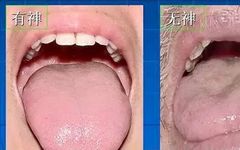 Click above to follow us for free!
Click above to follow us for free!
Observing the tongue quality The tongue quality, or the body of the tongue, is also known as the tongue body, which consists of the tongue’s muscle and vascular tissue. Observing the tongue body mainly involves examining the tongue spirit, tongue color, tongue shape, tongue state, and the sublingual vessels.1. Tongue Spirit(1) With Spirit (Glorious Tongue)【Tongue Manifestation Characteristics】 The tongue color is red and vibrant, moist and supple, with agile movement.【Clinical Significance】 A glorious tongue indicates vitality; even in illness, it is a good sign.【Mechanism Analysis】 A glorious tongue primarily reflects sufficient body fluids, abundant qi and blood, and robust spirit. The “Guide to Tongue Observation – Differentiating Tongue Spirit and Qi” states: “If the tongue quality is luminous and substantial, regardless of yellow, white, gray, or black, scraping reveals a red and moist interior, and the spirit is radiant, all diseases are auspicious.” (2) Without Spirit (Dry Tongue) 【Tongue Manifestation Characteristics】 The tongue color is dry, dull, lifeless, and lacks vitality, with impaired movement.【Clinical Significance】 A dry tongue indicates a lack of spirit, which is a dangerous sign.【Mechanism Analysis】 A dry tongue primarily reflects a deficiency of body fluids, severe qi and blood depletion, and a decline in spirit. The “Guide to Tongue Observation – Differentiating Tongue Spirit and Qi” states: “If the tongue quality is devoid of luster and substance, regardless of whether there is coating or not, if the interior appears dry and dull, and the spirit is entirely absent, all diseases are ominous.”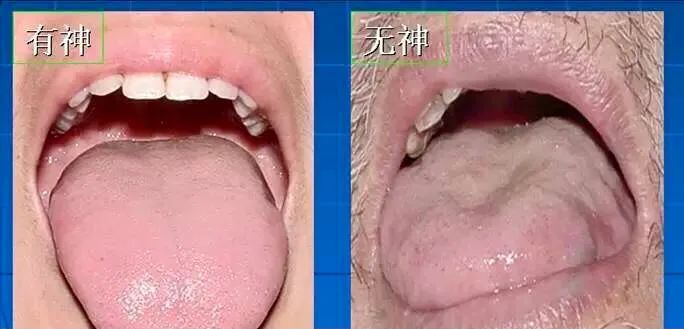 2. Tongue ColorThe tongue color refers to the color of the tongue body.Generally, it is classified into six types: pale red, pale white, red, crimson, blue, and purple.(1) Pale Red Tongue【Tongue Manifestation Characteristics】 The tongue body is pale red and moist, with a white base showing a hint of red.【Clinical Significance】 A pale red tongue is a sign of harmonious qi and blood, commonly seen in healthy individuals. In disease, it often indicates a mild condition.【Mechanism Analysis】 A pale red tongue primarily reflects a physiological state of sufficient heart qi and blood, and vigorous stomach qi. The formation principle of tongue color is similar to that of skin color; red indicates blood, and brightness and luster indicate the vitality of stomach qi. As stated in the “Tongue Manifestation Compendium”: “A pale red tongue is the sign of a healthy person… Red indicates heart qi, and pale indicates stomach qi.”In the early stages of an external pathogen, when the condition is mild and has not yet harmed qi, blood, or internal organs, the tongue color can remain normal and pale red; in cases of internal injury, it indicates a balance of yin and yang, and sufficient qi and blood, often suggesting a mild condition or a sign of recovery from illness.
2. Tongue ColorThe tongue color refers to the color of the tongue body.Generally, it is classified into six types: pale red, pale white, red, crimson, blue, and purple.(1) Pale Red Tongue【Tongue Manifestation Characteristics】 The tongue body is pale red and moist, with a white base showing a hint of red.【Clinical Significance】 A pale red tongue is a sign of harmonious qi and blood, commonly seen in healthy individuals. In disease, it often indicates a mild condition.【Mechanism Analysis】 A pale red tongue primarily reflects a physiological state of sufficient heart qi and blood, and vigorous stomach qi. The formation principle of tongue color is similar to that of skin color; red indicates blood, and brightness and luster indicate the vitality of stomach qi. As stated in the “Tongue Manifestation Compendium”: “A pale red tongue is the sign of a healthy person… Red indicates heart qi, and pale indicates stomach qi.”In the early stages of an external pathogen, when the condition is mild and has not yet harmed qi, blood, or internal organs, the tongue color can remain normal and pale red; in cases of internal injury, it indicates a balance of yin and yang, and sufficient qi and blood, often suggesting a mild condition or a sign of recovery from illness.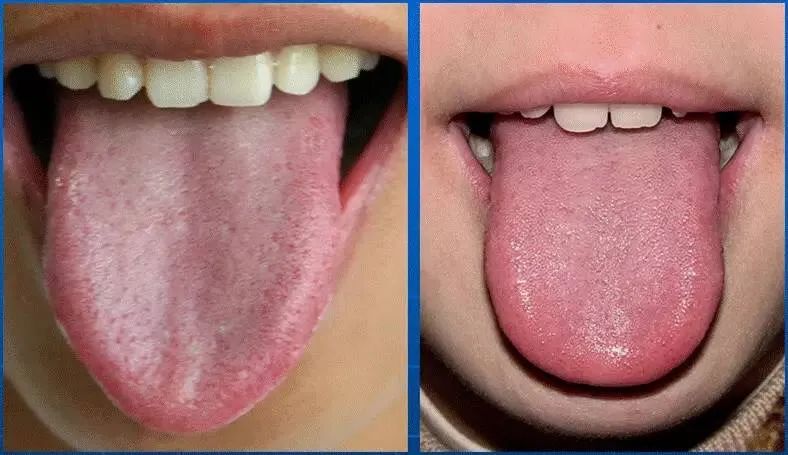 (2) Pale White Tongue【Tongue Manifestation Characteristics】 The tongue color is lighter than normal, with more white than red, referred to as a pale white tongue.If the tongue body is entirely white without any blood color, it is called a dry white tongue.【Clinical Significance】 Indicates deficiency of both qi and blood, and yang deficiency. A dry white tongue indicates damage to essence and loss of qi.【Mechanism Analysis】 Qi and blood deficiency leads to insufficient nourishment of the tongue, or yang qi deficiency results in weak blood circulation, causing the tongue color to be pale. Yang deficiency leads to internal cold, constricting the meridians, reducing blood flow to the tongue, which can also result in a pale tongue. The “Tongue Diagnosis” points out that a pale white tongue is the “fundamental color of a cold deficiency tongue.” If the tongue is pale and thin, it indicates deficiency of both qi and blood; if it is pale, moist, and the tongue body is plump and tender, it often indicates yang deficiency with water retention. Exhaustion of essence and blood, loss of qi, and insufficient nourishment of the tongue lead to a dry and white tongue, indicating a serious condition.Pale White Tongue▽
(2) Pale White Tongue【Tongue Manifestation Characteristics】 The tongue color is lighter than normal, with more white than red, referred to as a pale white tongue.If the tongue body is entirely white without any blood color, it is called a dry white tongue.【Clinical Significance】 Indicates deficiency of both qi and blood, and yang deficiency. A dry white tongue indicates damage to essence and loss of qi.【Mechanism Analysis】 Qi and blood deficiency leads to insufficient nourishment of the tongue, or yang qi deficiency results in weak blood circulation, causing the tongue color to be pale. Yang deficiency leads to internal cold, constricting the meridians, reducing blood flow to the tongue, which can also result in a pale tongue. The “Tongue Diagnosis” points out that a pale white tongue is the “fundamental color of a cold deficiency tongue.” If the tongue is pale and thin, it indicates deficiency of both qi and blood; if it is pale, moist, and the tongue body is plump and tender, it often indicates yang deficiency with water retention. Exhaustion of essence and blood, loss of qi, and insufficient nourishment of the tongue lead to a dry and white tongue, indicating a serious condition.Pale White Tongue▽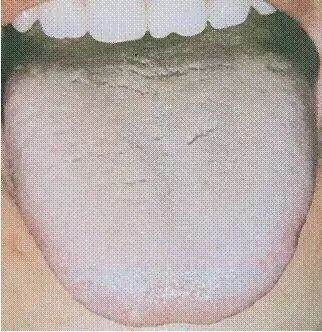 Dry White Tongue▽
Dry White Tongue▽ (3) Red Tongue【Tongue Manifestation Characteristics】 The tongue color is redder than normal, and if it is bright red, it is called a red tongue.【Clinical Significance】 Indicates excess heat or internal heat due to yin deficiency.【Mechanism Analysis】 Blood becomes active with heat, causing blood vessels to dilate and blood flow to accelerate, leading to a bright red tongue; or due to yin deficiency and dehydration, leading to internal heat rising to the tongue. A slightly red tongue or only the tip and edges being red often indicates the initial stage of an external heat condition. A red and cracked tongue tip often indicates heart fire rising. A red tongue on both sides often indicates excess heat in the liver channel. A red tongue with coating often indicates excess heat; a bright red tongue with little coating or cracks, or a thin and small tongue often indicates deficiency heat. The “Tongue Diagnosis” states: “A bright red tongue with no coating, no moisture at the tongue base, and no liquid on the tongue surface indicates yin deficiency and fire.”Red Tongue▽
(3) Red Tongue【Tongue Manifestation Characteristics】 The tongue color is redder than normal, and if it is bright red, it is called a red tongue.【Clinical Significance】 Indicates excess heat or internal heat due to yin deficiency.【Mechanism Analysis】 Blood becomes active with heat, causing blood vessels to dilate and blood flow to accelerate, leading to a bright red tongue; or due to yin deficiency and dehydration, leading to internal heat rising to the tongue. A slightly red tongue or only the tip and edges being red often indicates the initial stage of an external heat condition. A red and cracked tongue tip often indicates heart fire rising. A red tongue on both sides often indicates excess heat in the liver channel. A red tongue with coating often indicates excess heat; a bright red tongue with little coating or cracks, or a thin and small tongue often indicates deficiency heat. The “Tongue Diagnosis” states: “A bright red tongue with no coating, no moisture at the tongue base, and no liquid on the tongue surface indicates yin deficiency and fire.”Red Tongue▽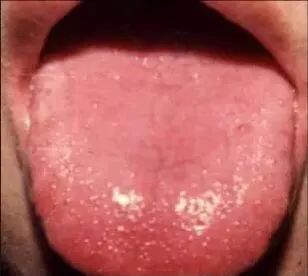 Red Tip and Edge▽
Red Tip and Edge▽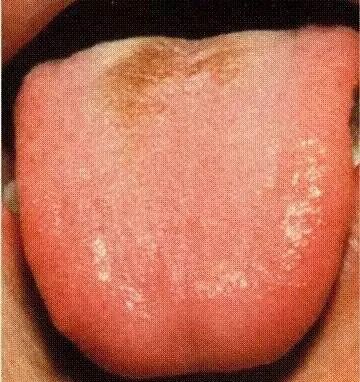 Bright Red Tongue with Little Coating▽
Bright Red Tongue with Little Coating▽ (4) Crimson Tongue【Tongue Manifestation Characteristics】 A tongue that is deeper red or slightly dark red is called a crimson tongue.【Clinical Significance】 Indicates excessive internal heat or vigorous fire due to yin deficiency.【Mechanism Analysis】 A crimson tongue often develops from a red tongue. The causes include excessive pathogenic heat, causing qi and blood to surge, leading to a red and crimson tongue; or heat entering the nutrient blood, damaging the yin of the nutrient, leading to concentrated blood and heat filling the tongue; or due to yin deficiency and dehydration, leading to internal fire rising to the tongue. Therefore, a crimson tongue indicates a more severe condition than a red tongue. A crimson tongue with coating often indicates external heat entering the nutrient blood or internal mixed diseases with excessive yang heat; the “Tongue Diagnosis” states: “Crimson is a deep red color. The heart governs the nutrient and blood; if the tongue coating is crimson and dry, the pathogen has entered the nutrient.” A crimson tongue with little or no coating indicates damage to the stomach and kidney yin, often due to the late stage of a heat disease or prolonged illness with vigorous fire due to yin deficiency, indicating deficiency heat.”
(4) Crimson Tongue【Tongue Manifestation Characteristics】 A tongue that is deeper red or slightly dark red is called a crimson tongue.【Clinical Significance】 Indicates excessive internal heat or vigorous fire due to yin deficiency.【Mechanism Analysis】 A crimson tongue often develops from a red tongue. The causes include excessive pathogenic heat, causing qi and blood to surge, leading to a red and crimson tongue; or heat entering the nutrient blood, damaging the yin of the nutrient, leading to concentrated blood and heat filling the tongue; or due to yin deficiency and dehydration, leading to internal fire rising to the tongue. Therefore, a crimson tongue indicates a more severe condition than a red tongue. A crimson tongue with coating often indicates external heat entering the nutrient blood or internal mixed diseases with excessive yang heat; the “Tongue Diagnosis” states: “Crimson is a deep red color. The heart governs the nutrient and blood; if the tongue coating is crimson and dry, the pathogen has entered the nutrient.” A crimson tongue with little or no coating indicates damage to the stomach and kidney yin, often due to the late stage of a heat disease or prolonged illness with vigorous fire due to yin deficiency, indicating deficiency heat.”
The gathering place for TCM book friends

▲Long press the QR code to “identify” and follow
Crimson Tongue▽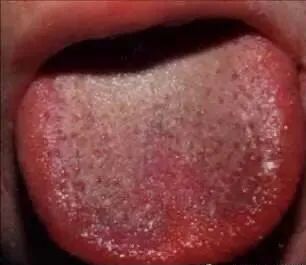
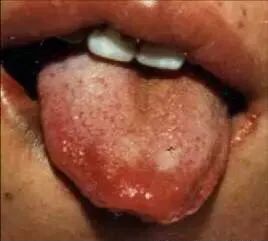
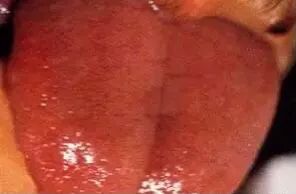 (5) Blue-Purple Tongue【Tongue Manifestation Characteristics】 The entire tongue appears uniformly blue or purple, or there are localized blue-purple spots, all referred to as blue-purple tongue.Blue-purple tongue can also present in various forms; if the tongue is pale but shows a blue-purple hue, it is called pale blue-purple tongue; if a red or crimson tongue shows a blue-purple hue, it is called purple-red or crimson-purple tongue; if there are localized blue-purple spots on the tongue, varying in size and not raised above the tongue surface, it is called “stasis spot tongue” or “stasis point tongue.”【Clinical Significance】 Indicates poor circulation of qi and blood.【Mechanism Analysis】 A blue-purple tongue is caused by poor circulation of qi and blood. A uniformly blue-purple tongue indicates significant stasis of blood, often due to systemic blood stasis; a tongue with purple spots indicates a lighter degree of stasis, often seen in localized stasis or localized vascular damage. The depth of the purple tongue color is related to the nature of cold and heat. A pale purple or dark purple and moist tongue is often seen in conditions of yang deficiency and excess yin. This is often due to internal cold, where yang qi is not expressed, leading to qi and blood stagnation. A blue tongue indicates severe cold and blood stasis, suggesting internal cold and stagnation of yang qi, leading to blood flow obstruction. A dark purple tongue or a crimson-purple tongue that is dry and lacks moisture, with little or no coating, is often seen in heat conditions, indicating severe heat toxin penetrating the nutrient blood, damaging the nutrient yin, and causing poor circulation of qi and blood. A blue-purple tongue can also be seen in certain congenital heart diseases or in cases of drug or food poisoning.Additionally, there may be traumatic injuries causing damage to blood vessels, leading to bleeding and spots on the tongue, which may not show obvious abnormalities. A dark purple tongue or spots on the tongue often indicate internal blood stasis.Pale Blue-Purple Tongue▽
(5) Blue-Purple Tongue【Tongue Manifestation Characteristics】 The entire tongue appears uniformly blue or purple, or there are localized blue-purple spots, all referred to as blue-purple tongue.Blue-purple tongue can also present in various forms; if the tongue is pale but shows a blue-purple hue, it is called pale blue-purple tongue; if a red or crimson tongue shows a blue-purple hue, it is called purple-red or crimson-purple tongue; if there are localized blue-purple spots on the tongue, varying in size and not raised above the tongue surface, it is called “stasis spot tongue” or “stasis point tongue.”【Clinical Significance】 Indicates poor circulation of qi and blood.【Mechanism Analysis】 A blue-purple tongue is caused by poor circulation of qi and blood. A uniformly blue-purple tongue indicates significant stasis of blood, often due to systemic blood stasis; a tongue with purple spots indicates a lighter degree of stasis, often seen in localized stasis or localized vascular damage. The depth of the purple tongue color is related to the nature of cold and heat. A pale purple or dark purple and moist tongue is often seen in conditions of yang deficiency and excess yin. This is often due to internal cold, where yang qi is not expressed, leading to qi and blood stagnation. A blue tongue indicates severe cold and blood stasis, suggesting internal cold and stagnation of yang qi, leading to blood flow obstruction. A dark purple tongue or a crimson-purple tongue that is dry and lacks moisture, with little or no coating, is often seen in heat conditions, indicating severe heat toxin penetrating the nutrient blood, damaging the nutrient yin, and causing poor circulation of qi and blood. A blue-purple tongue can also be seen in certain congenital heart diseases or in cases of drug or food poisoning.Additionally, there may be traumatic injuries causing damage to blood vessels, leading to bleeding and spots on the tongue, which may not show obvious abnormalities. A dark purple tongue or spots on the tongue often indicate internal blood stasis.Pale Blue-Purple Tongue▽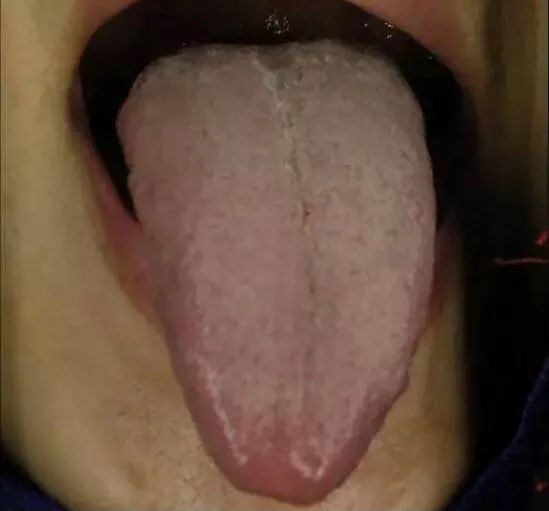 Blue-Purple Tongue▽
Blue-Purple Tongue▽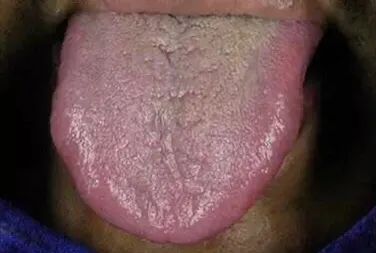 Crimson-Purple Tongue▽
Crimson-Purple Tongue▽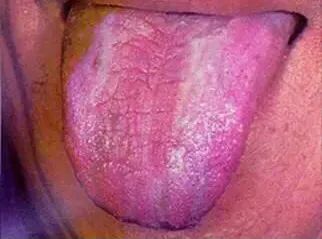 Stasis Point Tongue▽
Stasis Point Tongue▽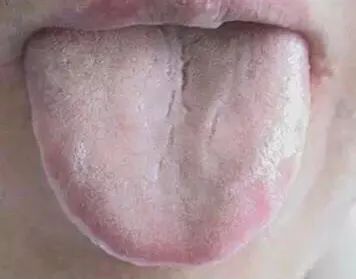 Stasis Spot Tongue▽
Stasis Spot Tongue▽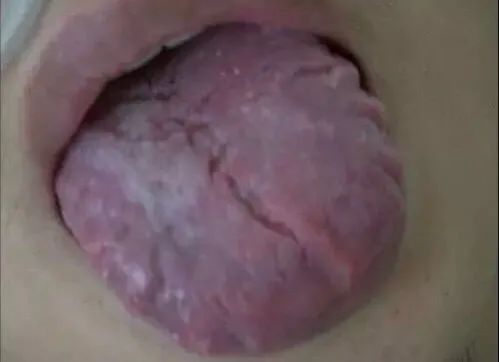 3. Tongue ShapeThe shape and quality of the tongue include aspects such as age, thickness, points, cracks, and teeth marks.(1) Old and Young【Tongue Manifestation Characteristics】 A tongue with rough or shriveled texture, firm and aged appearance, and darker color is called an old tongue; a tongue with fine texture, plump and tender appearance, and lighter color is called a young tongue.【Clinical Significance】 An old tongue is often seen in excess conditions; a young tongue is often seen in deficiency conditions.【Mechanism Analysis】 The quality of the tongue being old or young is a comprehensive manifestation. Old and young are indicators of the deficiency or excess of disease. The “Guide to Tongue Observation” states: “If the tongue quality is firm and aged, regardless of the coating color being white, yellow, gray, or black, the disease is mostly excess; if the tongue quality is plump and tender, regardless of the coating color being gray, black, yellow, or white, the disease is mostly deficiency.” When pathogenic qi is excessive and fills the body, the righteous qi is not weakened, and the pathogenic qi stagnates in the tongue, leading to an aged tongue. Insufficient qi and blood fail to nourish the tongue; or if yang qi is deficient, blood circulation is weak, leading to a young tongue with a pale color. Insufficient essence and blood lead to a young tongue that is red with little coating.Old Tongue▽
3. Tongue ShapeThe shape and quality of the tongue include aspects such as age, thickness, points, cracks, and teeth marks.(1) Old and Young【Tongue Manifestation Characteristics】 A tongue with rough or shriveled texture, firm and aged appearance, and darker color is called an old tongue; a tongue with fine texture, plump and tender appearance, and lighter color is called a young tongue.【Clinical Significance】 An old tongue is often seen in excess conditions; a young tongue is often seen in deficiency conditions.【Mechanism Analysis】 The quality of the tongue being old or young is a comprehensive manifestation. Old and young are indicators of the deficiency or excess of disease. The “Guide to Tongue Observation” states: “If the tongue quality is firm and aged, regardless of the coating color being white, yellow, gray, or black, the disease is mostly excess; if the tongue quality is plump and tender, regardless of the coating color being gray, black, yellow, or white, the disease is mostly deficiency.” When pathogenic qi is excessive and fills the body, the righteous qi is not weakened, and the pathogenic qi stagnates in the tongue, leading to an aged tongue. Insufficient qi and blood fail to nourish the tongue; or if yang qi is deficient, blood circulation is weak, leading to a young tongue with a pale color. Insufficient essence and blood lead to a young tongue that is red with little coating.Old Tongue▽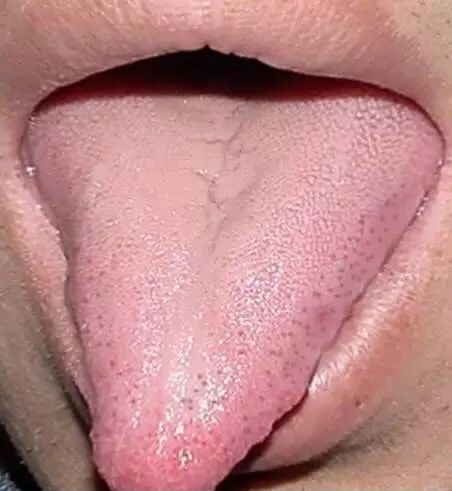 Young Tongue▽
Young Tongue▽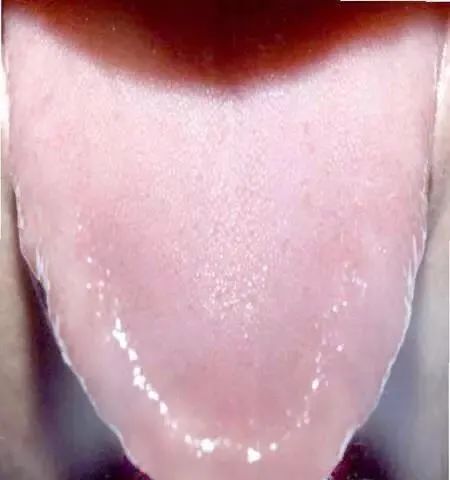 (2) Thick and Thin【Tongue Manifestation Characteristics】 A tongue that is larger and thicker than normal, filling the mouth, is called a thick tongue. A tongue that is smaller and thinner than normal is called a thin tongue.【Clinical Significance】 A thick tongue often indicates internal water retention; a swollen tongue indicates excessive heart and spleen heat, or external damp-heat. A thin tongue indicates insufficient qi and blood, or vigorous fire due to yin deficiency.【Mechanism Analysis】 A thick tongue is often due to spleen and kidney yang deficiency, leading to abnormal qi transformation and obstruction of fluid distribution, resulting in internal water retention. A pale white tongue with a thick body often indicates qi deficiency or yang deficiency. A red swollen tongue often indicates internal heat. A swollen tongue that is red and crimson is often seen in cases of excessive heart and spleen heat, or damp-heat accumulation. Additionally, patients with congenital tongue hemangiomas may present with localized swelling and purple color, which is a localized pathological change of blood vessel stasis, often without systemic diagnostic significance. A thin tongue is generally due to insufficient qi, blood, and body fluids, leading to a lack of nourishment. A thin tongue with a pale color is often seen in prolonged illness with deficiency of both qi and blood, where blood fails to nourish the tongue; a thin tongue with a red and crimson color, dry with little or no coating, is often seen in cases of vigorous fire due to yin deficiency, where body fluids cannot nourish the tongue, leading to a thin tongue, and vigorous fire leads to a red and crimson color, with dryness and little or no coating.Thick Tongue▽
(2) Thick and Thin【Tongue Manifestation Characteristics】 A tongue that is larger and thicker than normal, filling the mouth, is called a thick tongue. A tongue that is smaller and thinner than normal is called a thin tongue.【Clinical Significance】 A thick tongue often indicates internal water retention; a swollen tongue indicates excessive heart and spleen heat, or external damp-heat. A thin tongue indicates insufficient qi and blood, or vigorous fire due to yin deficiency.【Mechanism Analysis】 A thick tongue is often due to spleen and kidney yang deficiency, leading to abnormal qi transformation and obstruction of fluid distribution, resulting in internal water retention. A pale white tongue with a thick body often indicates qi deficiency or yang deficiency. A red swollen tongue often indicates internal heat. A swollen tongue that is red and crimson is often seen in cases of excessive heart and spleen heat, or damp-heat accumulation. Additionally, patients with congenital tongue hemangiomas may present with localized swelling and purple color, which is a localized pathological change of blood vessel stasis, often without systemic diagnostic significance. A thin tongue is generally due to insufficient qi, blood, and body fluids, leading to a lack of nourishment. A thin tongue with a pale color is often seen in prolonged illness with deficiency of both qi and blood, where blood fails to nourish the tongue; a thin tongue with a red and crimson color, dry with little or no coating, is often seen in cases of vigorous fire due to yin deficiency, where body fluids cannot nourish the tongue, leading to a thin tongue, and vigorous fire leads to a red and crimson color, with dryness and little or no coating.Thick Tongue▽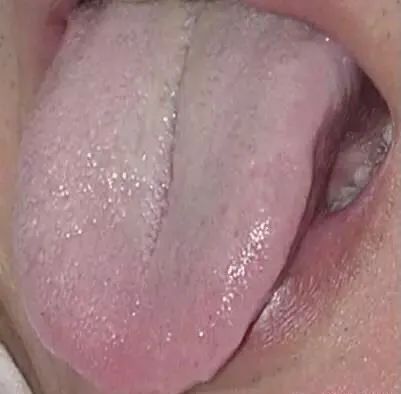
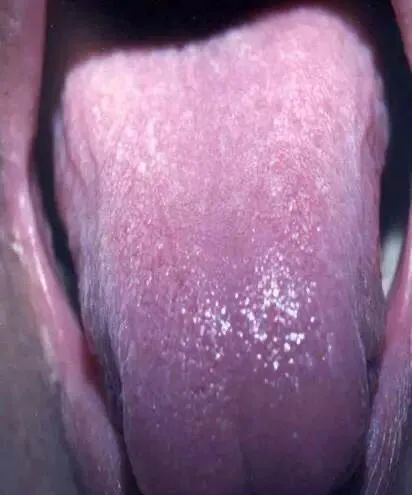
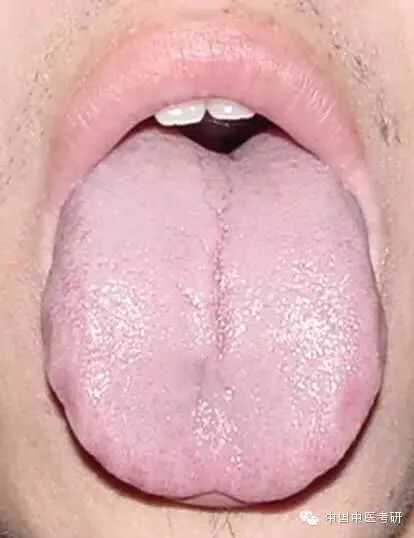 Thin Tongue▽
Thin Tongue▽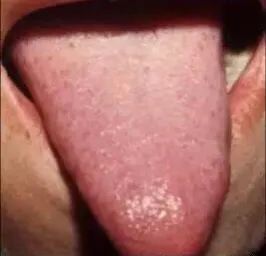
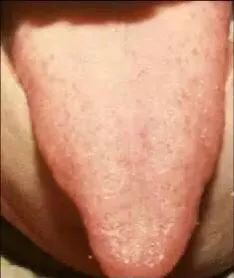
 (3) Points and Spikes【Tongue Manifestation Characteristics】 Points refer to raised red or purple-red spots on the tongue surface. Larger ones are called stars, and smaller ones are called points. Red ones are called red star tongue or red point tongue; white ones are called white star tongue. Spikes refer to enlarged and protruding fungiform papillae forming sharp peaks, resembling thorns, called thorn tongue. Points and spikes are similar and can occur together, hence collectively referred to as point-spike tongue. Point-spike tongue is most commonly seen at the tip of the tongue.【Clinical Significance】 Indicates excessive yang heat in the organs, or heat in the blood.Based on the location of the points and spikes, one can generally infer where the heat is located; for example, if points and spikes appear at the tip of the tongue, it often indicates excessive heart fire; if they appear in the middle of the tongue, it often indicates excessive stomach and intestinal heat; if they appear on both sides of the tongue, it often indicates liver and gallbladder heat, etc.【Mechanism Analysis】 Points and spikes are pathological features of swollen or protruding fungiform papillae. Points are enlarged and increased in number, with the papillae filled with blood and edema, even forming sharp peaks resembling thorns, often due to internal heat and pathogenic factors filling the tongue. The number of points and spikes correlates with the degree of pathogenic heat; the more points and spikes, the more severe the heat. Observing the color of the points and spikes can estimate the circulation of qi and blood and the severity of the disease. For example, bright red points indicate excessive heat in the blood or vigorous fire due to yin deficiency; dark purple points indicate heat and stagnation of qi and blood.
(3) Points and Spikes【Tongue Manifestation Characteristics】 Points refer to raised red or purple-red spots on the tongue surface. Larger ones are called stars, and smaller ones are called points. Red ones are called red star tongue or red point tongue; white ones are called white star tongue. Spikes refer to enlarged and protruding fungiform papillae forming sharp peaks, resembling thorns, called thorn tongue. Points and spikes are similar and can occur together, hence collectively referred to as point-spike tongue. Point-spike tongue is most commonly seen at the tip of the tongue.【Clinical Significance】 Indicates excessive yang heat in the organs, or heat in the blood.Based on the location of the points and spikes, one can generally infer where the heat is located; for example, if points and spikes appear at the tip of the tongue, it often indicates excessive heart fire; if they appear in the middle of the tongue, it often indicates excessive stomach and intestinal heat; if they appear on both sides of the tongue, it often indicates liver and gallbladder heat, etc.【Mechanism Analysis】 Points and spikes are pathological features of swollen or protruding fungiform papillae. Points are enlarged and increased in number, with the papillae filled with blood and edema, even forming sharp peaks resembling thorns, often due to internal heat and pathogenic factors filling the tongue. The number of points and spikes correlates with the degree of pathogenic heat; the more points and spikes, the more severe the heat. Observing the color of the points and spikes can estimate the circulation of qi and blood and the severity of the disease. For example, bright red points indicate excessive heat in the blood or vigorous fire due to yin deficiency; dark purple points indicate heat and stagnation of qi and blood.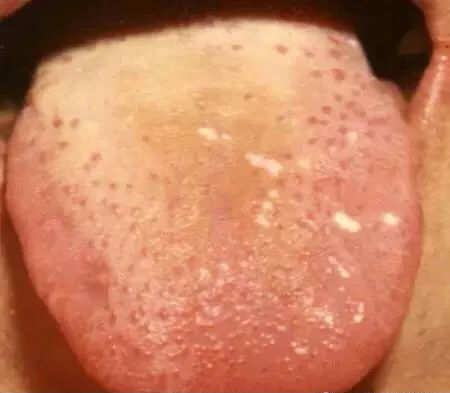
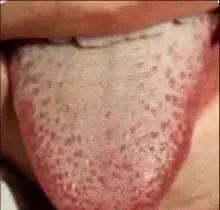
 (4) Cracks【Tongue Manifestation Characteristics】 Various shapes of cracks or fissures appear on the tongue surface, varying in depth and number, collectively referred to as cracked tongue.If the cracks or fissures are not covered by tongue coating, they often indicate pathological changes; cracks can present in shapes like “人”, “|”, or “井”, and in severe cases, they can appear convoluted, pebble-like, or as if cut or shredded. If there is coating in the cracks, it is often seen in congenital cracks.【Clinical Significance】 Often seen in cases of essence and blood deficiency, or vigorous fire due to yin deficiency, or spleen deficiency and qi weakness.【Mechanism Analysis】 Cracked tongue is often caused by insufficient nourishment of the tongue, atrophy of the tongue papillae, or tissue fissuring. It is a manifestation of systemic malnutrition. A pale white tongue with cracks indicates blood deficiency, often due to blood deficiency failing to nourish the tongue, hence the “Guide to Tongue Observation” states: “Those with cracks indicate blood deficiency.” Fewer and shallower cracks indicate mild deficiency; more and deeper cracks indicate severe deficiency. A red and cracked tongue indicates damage to body fluids due to excessive heat or vigorous fire due to yin deficiency, leading to loss of nourishment. A uniformly crimson tongue, or one with horizontal or vertical cracks that are short, indicates yin deficiency and fluid depletion.In healthy individuals, about 0.5% have deep grooves on the tongue surface, with coating in the cracks, and no discomfort, indicating congenital tongue fissures, which differ from pathological cracked tongue.
(4) Cracks【Tongue Manifestation Characteristics】 Various shapes of cracks or fissures appear on the tongue surface, varying in depth and number, collectively referred to as cracked tongue.If the cracks or fissures are not covered by tongue coating, they often indicate pathological changes; cracks can present in shapes like “人”, “|”, or “井”, and in severe cases, they can appear convoluted, pebble-like, or as if cut or shredded. If there is coating in the cracks, it is often seen in congenital cracks.【Clinical Significance】 Often seen in cases of essence and blood deficiency, or vigorous fire due to yin deficiency, or spleen deficiency and qi weakness.【Mechanism Analysis】 Cracked tongue is often caused by insufficient nourishment of the tongue, atrophy of the tongue papillae, or tissue fissuring. It is a manifestation of systemic malnutrition. A pale white tongue with cracks indicates blood deficiency, often due to blood deficiency failing to nourish the tongue, hence the “Guide to Tongue Observation” states: “Those with cracks indicate blood deficiency.” Fewer and shallower cracks indicate mild deficiency; more and deeper cracks indicate severe deficiency. A red and cracked tongue indicates damage to body fluids due to excessive heat or vigorous fire due to yin deficiency, leading to loss of nourishment. A uniformly crimson tongue, or one with horizontal or vertical cracks that are short, indicates yin deficiency and fluid depletion.In healthy individuals, about 0.5% have deep grooves on the tongue surface, with coating in the cracks, and no discomfort, indicating congenital tongue fissures, which differ from pathological cracked tongue.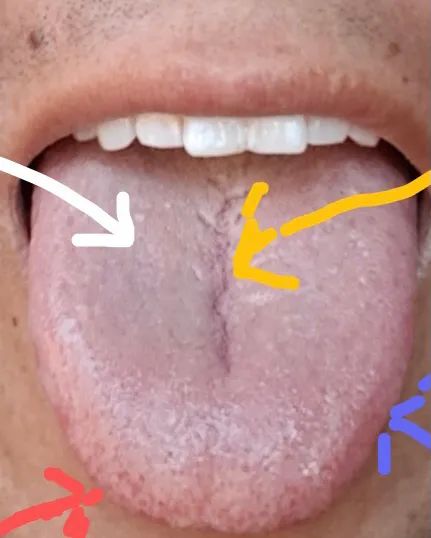
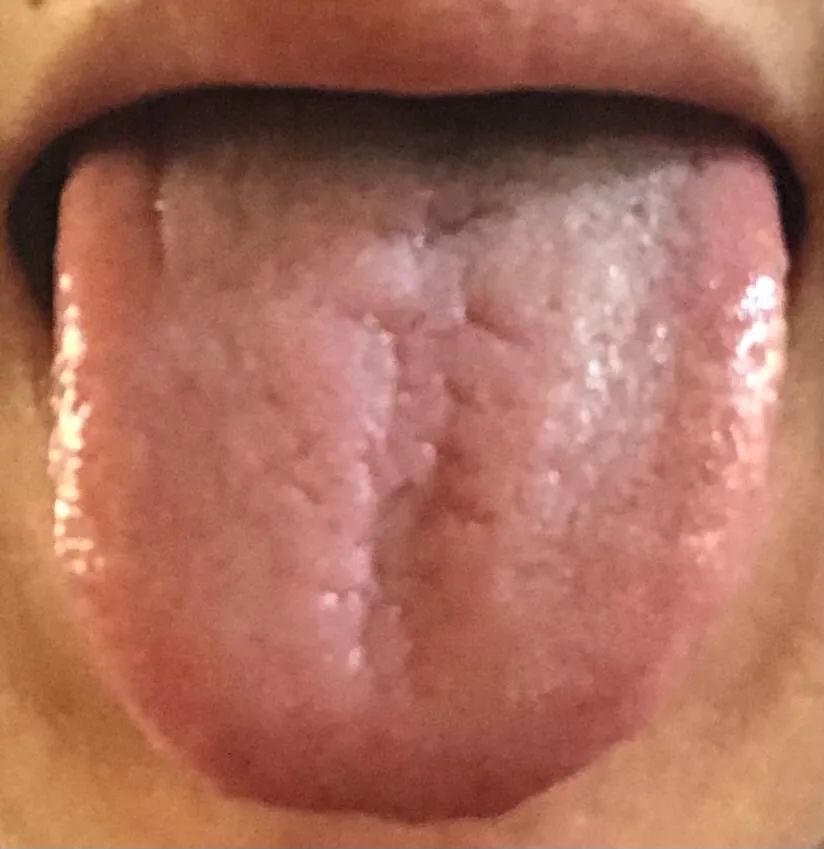 (5) Teeth Marked Tongue【Tongue Manifestation Characteristics】 The edges of the tongue show marks from teeth pressure, often accompanied by a plump tongue body.【Clinical Significance】 Indicates spleen deficiency and internal water retention.【Mechanism Analysis】 Teeth marks on the tongue edges are often due to pressure from a plump tongue body against the teeth. Therefore, it is often seen with a thick tongue. A tongue that is not plump but has teeth marks is referred to as a delicate teeth-marked tongue. A pale and plump tongue that is moist, with teeth marks on the edges, often indicates internal cold and dampness, or yang deficiency with water retention; a pale red tongue with teeth marks is commonly seen in spleen deficiency and qi deficiency; if the tongue is red, swollen, and fills the mouth, with teeth marks, it indicates internal damp-heat accumulation. Additionally, those with congenital teeth-marked tongues often have a tongue that is not large, pale red, and tender, with slight teeth marks; in pathological cases, it indicates a milder condition, often seen in children and those with qi and blood deficiency.
(5) Teeth Marked Tongue【Tongue Manifestation Characteristics】 The edges of the tongue show marks from teeth pressure, often accompanied by a plump tongue body.【Clinical Significance】 Indicates spleen deficiency and internal water retention.【Mechanism Analysis】 Teeth marks on the tongue edges are often due to pressure from a plump tongue body against the teeth. Therefore, it is often seen with a thick tongue. A tongue that is not plump but has teeth marks is referred to as a delicate teeth-marked tongue. A pale and plump tongue that is moist, with teeth marks on the edges, often indicates internal cold and dampness, or yang deficiency with water retention; a pale red tongue with teeth marks is commonly seen in spleen deficiency and qi deficiency; if the tongue is red, swollen, and fills the mouth, with teeth marks, it indicates internal damp-heat accumulation. Additionally, those with congenital teeth-marked tongues often have a tongue that is not large, pale red, and tender, with slight teeth marks; in pathological cases, it indicates a milder condition, often seen in children and those with qi and blood deficiency.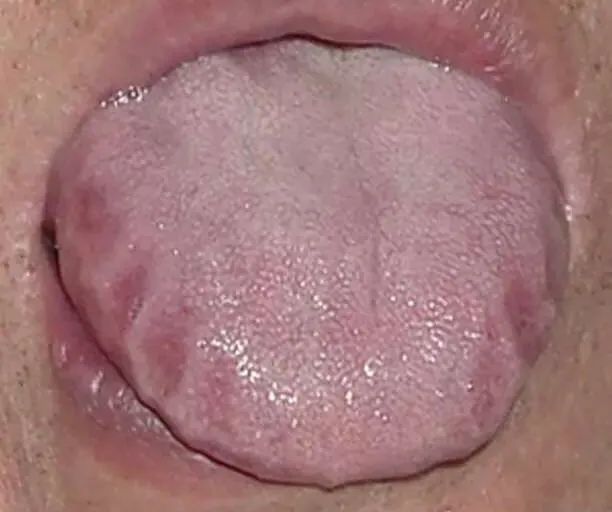
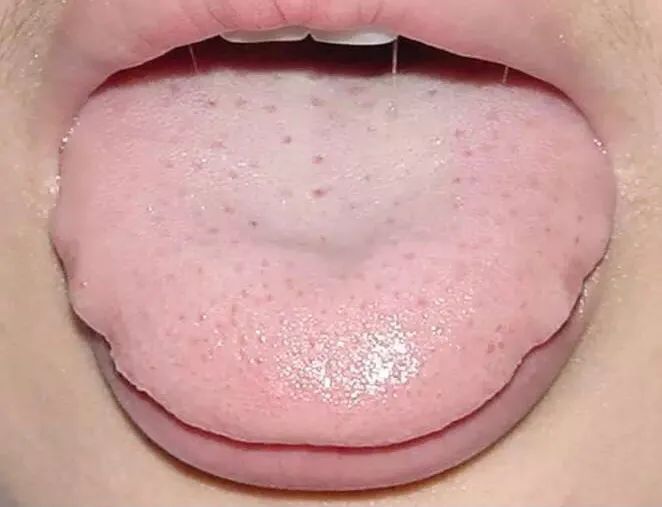
Copyright Statement: We emphasize sharing; articles and images are sourced from the internet, and copyright belongs to the original authors.
A small effort can yield great merit!
“The Medical Chronicles of Xiao Lang Zhong” – A TCM story of a grandfather and grandson.。
Recommended public accounts to follow
FollowQi Huang Medical Society for disease search

Rheumatism, bone hyperplasia, low back pain, joints, shoulder periarthritis, cervical spondylosis, kidney tonification, liver nourishment,
weight loss, gynecological diseases, menstrual irregularities, cold uterus, acne, constipation, insomnia, rhinitis,
heart disease, diabetes, high blood sugar, high blood pressure, slim legs, white hair, hair loss,
oral ulcers, snoring, cramps, colds, coughs, sore throat, dampness

